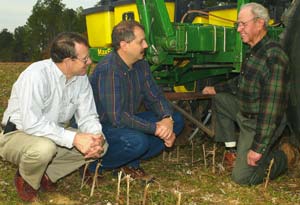Cutting-Edge Invention Solves Residue Riddle

As a pioneer of no-till farming in Alabama and a strong advocate of the practice, Lee County Farmers Federation President Tom Ingram knows the value of a good cover crop. Experience has taught him that a dense mat of rye residue will reduce erosion, conserve soil moisture and improve the organic matter content of the soil.But two years ago, the cotton farmer faced an unusual problem. He had too much residue. “We had a good cover crop of rye, but we couldn’t get in to burn it down with Roundup at the right time because the ground was too wet,” Ingram recalled. “We had to wait until the ground dried out, and by that time the rye was more than head high.”We were in the field trying to plant the cotton crop, and we couldn’t because the planter kept choking up,” Ingram added. “We kept having to stop and clean it, so we finally went home and sat down and thought of a way to fix it. We had to do something so we could plant.”Working with Allen Torbert, an agricultural research service scientist with the National Soil Dynamics Laboratory in Auburn, Ingram designed and constructed what they call a “forward residue mover.”The simple device mounts in front of the planter’s residue manager wheels and attaches to the coulter bracket. It consists of two 18-inch-long pieces of angle iron and one 18-inch piece of channel iron, which are welded together to form an equilateral triangle. Four short pieces of rebar welded to the underside of the angle iron provide attachment points for lengths of flexible tubing, which push the residue aside as the planter moves forward.”The row cleaner keeps the planter from clogging so the planting runs smoothly,” said Ingram, who plants about 600 acres of cotton each year on his farm that sprawls through Lee, Macon and Russell counties. Torbert, who was conducting a no-till experiment with Ingram when they first realized the need for the residue mover, said the invention has been invaluable.”We were on the tractor trying to plant, and we would go 50 yards and have to get off and untangle the residue,” Torbert recalled. “Every time the planter became clogged with residue, some seeds were missed–which could result in a poor stand. In some years, this isn’t a problem. But in years when you get a good cover crop, you really need a tool like this.”Ingram said he’s used the device for the past two years and has had good results.”It helps make sure the seeds are placed under
the soil instead of on top. With cotton especially, it is critical to have the right seed placement. This device helps keep the ground clean, and helps you get good seed depth,” he said.Ingram says he and Torbert do not plan to market the device or to apply for a patent.”Most farmers come up with things like this to help them,” he said. “We just wanted to tell people about it so they could make one if they need it. It’s pretty easy to make.”Jeff Clary, county coordinator for the Alabama Cooperative Extension System in Lee County, said Ingram is always coming up with innovative ways to improve farming.”Tom Ingram has always been a pioneer in improving farming practices and techniques,” he said. “The residue remover that he and Allen Torbert developed is just one of many innovations that he has made that has helped his and others’ farming operations.”Ingram’s other engineering accomplishments include a hooded sprayer, a hydraulic packer for cotton wagons and a residue chopper.Clary said Ingram began farming all of his cotton using no-till practices in 1985, following an Extension demonstration on his farm. “At that time, it was most unusual for a person who had been farming traditionally for so long to completely switch to no-till,” Clary said.Since then, Ingram has become something of an ambassador for conservation tillage in Alabama, Torbert added. He has hosted field days, helped with on-farm demonstrations and shared his expertise with others. “We can show that conservation tillage will work on an experiment station, and that’s all well and good. But, we really need to show that a farmer can do it on a large scale and make money,” Torbert said. “This residue mover is another example of Ingram coming across a problem and finding a solution to it.”We are trying to let as many people as we can know about the residue mover,” Torbert added. “The whole idea that you can get a good stand with residue is foreign to some farmers. And, if they start running into problems, some will just abandon conservation tillage altogether. This device resolves one of those problems.”Ingram said he hopes the residue mover will alleviate some of the concerns other farmers have with conservation tillage and encourage them to give the practice another chance.”Conservation tillage has so many benefits for farmers,” he said. It saves us time, saves us money, saves fuel, saves energy–it saves everything. We just had to come up with something to help us plant.”
